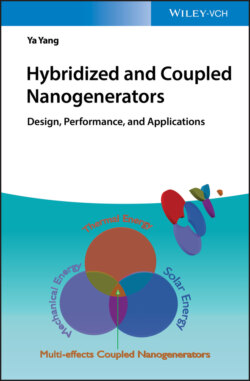Читать книгу Hybridized and Coupled Nanogenerators - Ya Yang - Страница 13
1.2.2 Electromagnetic–Triboelectric Hybridized Nanogenerators
ОглавлениеThe electromagnetic effect is due to the electromagnetic induction in Faraday's law, where the magnet and the coil have relative movements to induce the voltage/current signals. The working of a TENG is based on the coupling effect between the triboelectrification effect and the electrostatic induction in the periodical mechanical motion process [2]. In 2015, Prof. Ya Yang and coworkers first developed a method to integrate an EMG and a TENG in one device [8], so that the same mechanical motions can generate more electric energy due to the use of two energy scavenging devices. The corresponding energy conversion efficiency from mechanical energy to electric energy can be largely increased. This method has been rapidly extended to scavenge many kinds of other mechanical energies, such as wind energy [30], biomechanical energy [31], rotational energy [11], and so on.
To harvest vibration energy, Wu et al. demonstrated a spring‐based hybridized nanogenerator including an EMG and a TENG [8], as illustrated in Figure 1.2a. In the vibration process, the electromagnetic and triboelectric effects can coexist in the same mechanical motions, which can effectively enhance the energy conversion efficiency. Figure 1.2b displays a photograph of the device, where the TENG can work under the periodical mechanical motions. Moreover, the working of an EMG is based on the relative mechanical motions between the magnet and the coils. Figure 1.2c illustrates the photograph of the vibration part. The pyramid microstructures with average sizes smaller than 10 μm can be found on the surfaces of the PDMS films, as shown in Figure 1.2d. The output voltage of the TENG can be up to 600 V, and the corresponding output current can be about 3.5 μA. Under the same mechanical motions, the output voltage of the EMG can be about 3 V and the output current can be about 1 mA.
Figure 1.2 Electromagnetic–triboelectric hybridized nanogenerator for scavenging vibration energy. (a) Schematic diagram of the electromagnetic–triboelectric hybridized nanogenerator. (b) Photograph of the fabricated device. (c) Photograph of vibration part in the device. (d) SEM of the PDMS surface with micro/nanostructures.
Source: Reproduced with permission from Wu et al. [8]. Copyright 2015, Elsevier.
To scavenge wind energy, Wang et al. designed an electromagnetic–triboelectric hybridized nanogenerator, which is based on a tube structure [12]. As displayed in Figure 1.3a, the Kapton film can vibrate in the tube when wind goes through the tube from the right side of the device to the left side of the device [32]. By utilizing a high‐speed camera, we can find that the effective contact between the two electrodes and the Kapton film for the TENG is mainly at the left side of the acrylic tube (marked with red dot line). There is no contact between the Kapton film and the two electrodes at the right most region of the tube, where most of the vibration energy was wasted due to the required effective contact/separation for the working of the TENGs. By integrating an EMG at the right region of the device in Figure 1.3b, the wind‐driven vibration of the organic film can drive the working of the EMG and generate more electricity [12]. To understand the ratios of the produced energies for the two generators, we can calculate the electricity generated in the time of 10 seconds, where the TENG can give 2.6 mJ while the EMG can give 3.2 mJ. The total energy for the electromagnetic–triboelectric hybridized nanogenerator is 5.8 mJ, which is larger than that of the individual TENG by over 130%. Moreover, Wang and Yang reported a hybridized nanogenerator, where the two ends of the Kapton vibration film have been fixed to harvest wind energy [19]. Although many kinds of electromagnetic–triboelectric hybridized nanogenerators have been reported, all these devices are based on the same idea of integrating the two kinds of energy scavenging units into one system to scavenge the same energies for enhancing the energy conversion efficiency.
Figure 1.3 Electromagnetic–triboelectric hybridized nanogenerator for scavenging wind energy. (a) Photographs of the triboelectric nanogenerator (TENG) for harvesting wind energy.
Source: Reproduced with permission from Wang et al. [32]. Copyright 2015, John Wiley and Sons.
(b) Photograph of the hybridized nanogenerator including a TENG and an electromagnetic generator (EMG) for harvesting wind energy.
Source: Reproduced with permission from Wang et al. [12]. Copyright 2015, American Chemical Society.
